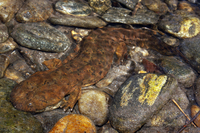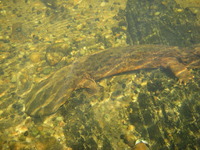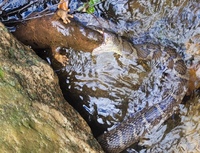Taxonomy
Class: AmphibiaOrder: CaudataFamily: Cryptobranchidae
Taxonomic Comments: The Hellbender (Cryptobranchus alleganiensis ) is an unmistakable giant salamander that inhabits cool, rocky streams in the eastern US. Taxonomists have traditionally recognized two subspecies that are best identified by geographic range and color patterns. The Eastern Hellbender (C. a. alleganiensis ) occurs in central and southwestern Missouri, and from southern New York southwestward to northern Alabama and extreme northeastern Mississippi. Adults of this subspecies typically have small black spots on the dorsum and a uniformly colored chin; however, adults in southern populations are sometimes blotched (Petranka 1998). The Ozark hellbender (C. a. bishopi ) occurs in southeastern Missouri and adjoining portions of Arkansas. The adults are smaller on average and have large blotches on the dorsum and a chin that is heavily mottled with dark pigmentation.Cryptobranchus underwent a dramatic Pleistocene range contraction to a southern refugium that was followed by a more recent range expansion. C. a. bishopi and C. a. alleganiensis . This mostly reflected variation across major drainage basins. Three major clusters were identified that represented C. a. alleganiensis and two clusters within C. a. bishop . The two C. a. bishop clusters were as different from each other as they were when paired with C. a. alleganiensis from central Missouri. Unger et al. (2013) conducted a similar survey of genetic variation across the range of the eastern subspecies using microsatellite markers. They found two major genetic groups that consisted of one associated with the northern Ohio River drainage, and a second associated with the Tennessee River drainage to the south. A more detailed analysis of the southern group (Freake et al. 2018) revealed four strongly supported clusters which correspond to specific watersheds. Populations from western North Carolina are members of two of these groups; one in the French Broad River and a second in the Hiwassee/Little Tennessee/Little River drainage. Applegate et al. (2018) only recognized four major evolutionary lineages in the eastern subspecies. These include groups in the Ohio River drainage, the Kanawha River drainage, the Tennessee River drainage, and the Missouri River drainage. North Carolina populations are members of two of these groups.Cryptobranchus -- and evidence that C. a. bishopi and C. a. alleganiensis are paraphyletic (Crowhurst et al. 2011, Sabatino and Routman 2009) -- taxonomists continue to recognize these subspecies. Since they are allopatric they are best recognized by range. Species Comments:
Identification
Description: Cryptobranchus alleganiensis is a large, slimy, aquatic salamander that reaches 30-74 cm TL. The body and head are strongly flattened dorso-ventrally and the eyes are small and lidless. The skin is noticeably wrinkled, and a fleshy fold of skin occurs along each side of the body. The tail is laterally flattened and shorter than the remainder of the body. The dorsal ground color varies from greenish to yellowish brown or slate gray and is overlain with varying amounts of black spotting or blotching (Petranka 1998). Albinos and morphs with orangish ground colors have occasionally been found. Adult males develop swollen cloacal glands during the breeding season, and on average are about the same length as the females. The larvae undergo partial metamorphosis so that the adults have a single pair of circular gill openings. These are sometimes missing on one or both sides of the head (Petranka 1998). Online Photos: Google iNaturalist AmphibiaWeb Account
Distribution in North Carolina
Distribution Comments: Cryptobranchus alleganiensis is found east of the Mississippi River from southern New York southwestward through the Appalachian region to northern Georgia, Alabama and extreme northeastern Mississippi, and westward to Tennessee, Kentucky, and southern Illinois. Two disjuncts occur west of the Mississippi River in Missouri and northern Arkansas. Populations in North Carolina are found in medium to larger streams and rivers at lower elevations in the mountains. Distribution Reference: Beane et al. 2010County Map: Clicking on a county returns the records for the species in that county.
GBIF Global Distribution
Key Habitat Requirements
Habitat: Hellbenders inhabit large, rocky, fast-flowing streams that are well oxygenated. They are generally found at elevations below 762 m (2500’) and are most commonly found beneath large rocks or rocky shelves in or near shallow rapids (Hillis and Bellis 1971, Nickerson and Mays 1973a). Suitable rocky habitats are often patchily distributed along stream stretches and may be interspersed with large reaches of unsuitable habitat that lack the adults and larvae. Crayfishes and small fishes are important prey, and streams with healthy prey populations, minimal sediment input, and numerous large, unembedded rocks provide ideal conditions. Rossell et al. (2013) examined the characteristics of shelters that were used by 41 hellbenders in western North Carolina. All of the animals were found beneath large rocks that typically had flat bottoms, deep cavities, and sand and gravel substrates. The shelter rocks were significantly larger than nearby rocks that were not used. Environmental and Physiological Tolerances: Hellbenders primarily obtain oxygen through their skin and will engage in rocking behavior when oxygen-stressed (Harlan and Wilkinson 1981). Rocking the body back and forth helps to distribute oxygenated water across the skin surface. Local populations appear to be restricted to cool, well-oxygenated streams due to physiological limitations associated with cutaneous respiration. Biotic Relationships: The natural predators of hellbenders are poorly documented. The adults produce very slimy skin secretions that are noxious to some predators, and their large size limits losses from gape-limited predators. Nonetheless, this species is occasionally preyed upon by large fish, turtles, and watersnakes (Petranka 1998). The eggs and larvae are frequently eaten by conspecifics, and hatchlings and small larvae undoubtedly are taken by many aquatic predators. The Northern Watersnake (Nerodia s. sipedon ) has been documented feeding on hellbenders in North Carolina on several occasions.
Life History and Autecology
Breeding and Courtship: The breeding season in most local populations last for 3-4 weeks and varies among populations depending on the location and local site conditions. Breeding can occur anytime between mid-August and mid-November, but most populations appear to breed from mid-August through mid-September, including those in North Carolina (Petranka 1998, Unger et al. 2020b). Peterson et al. 1989a documented an exceptional population in the Spring River of Arkansas that breeds primarily in January when populations throughout the remainder of the range have ceased breeding. Sex ratios in most Ozark populations are usually close to 1:1 (Nickerson and Mays 1973a, Peterson 1987), but males frequently outnumber females in eastern populations (e.g., Hillis and Bellis 1971, Pfingsten 1990). Cryptobranchus has external fertilization. The males produce a milky seminal fluid rather than spermatophores and deposit the seminal fluid directly on the eggs as they are being laid. Both sexes tend to become restless shortly before mating. They frequently move about the stream bed during the day and prod with their noses beneath crevices under rocks in search of mates (Petranka 1998). In some instances as many as 6-12 adults may congregate on the stream bottom. Reproductive Mode: Females lay their eggs in beaded strings in depressions within the males' burrows (Nickerson and Mays 1973a, Smith 1907). The freshly-laid ova are pale to light yellow, 5-7 mm in diameter, and are surrounded by two gelatinous envelopes. Freshly laid eggs with the surrounding envelopes are 18-20 mm in diameter and are separated from adjoining eggs by short cords that are 5-10 mm in length (Petranka 1998). Aquatic Life History: Hatchlings have conspicuous yolk sacs and presumably rely on yolk as an energy source for the first few months after hatching (Petranka 1998). Hatchlings in New York grow 35-40 mm during their first year of life and reach 68-70 mm TL when 1-year old (Bishop 1941). The larvae partially transform and lose their external gills after reaching 100-130 mm TL and 1.5-2 years of age (Bishop 1941, Nickerson and Mays 1973a, Smith 1907, 1912). Eurycea larva. Unger et al. (2020c) used DNA barcoding to determine dietary items of specimens from two western North Carolina streams and found that the larvae feed heavily on mayflies. Other prey included stoneflies, a chiromonid larva and an earthworm.
General Ecology
Population Ecology: Factors that regulate local populations are poorly understood, but competition for large rocks that are used for cover and brooding may set an upper limit on population size. Unger et al. (2013) conducted a survey of genetic variation across the range of the eastern subspecies and found that populations in different reaches of the same stream often showed significant genetic differences and exhibited genetic isolation by stream distance. This likely reflects the fact that suitable rocky habitats are patchily distributed in streams and that individuals do not disperse long distances within streams. Most genetic variation that was observed across the range of the species (>93%) reflected within stream variation of this sort, with only a small percentage due to higher hierarchical levels. Community Ecology: Although the natural history of Cryptobranchus is well documented, the ecological interactions of Cryptobranchus with other community members and its functional role in communities are poorly understood. This species appetite for crayfishes suggests that it may play an important role in regulating crayfish populations in some streams.
Adverse Environmental Impacts
Habitat Loss: Cryptobranchus requires fast-flowing water to survive. The construction of dams and large reservoirs has eliminated many miles of suitable habitat and caused populations to become fragmented and isolated.
Status in North Carolina
NHP State Rank: S3Global Rank: G3Status in North Carolina: SCGlobal Status: PS,E,URPopulations: Resurveys of historical collection sites indicate that Cryptobranchus has undergone extensive declines in many areas of its range. For example, Graham et al. (2011) surveyed 45 sites in 29 streams in northern Alabama and were unable to find a single hellbender, while Wineland et al. (2018) estimated that about 38% of known populations in West Virginia have been extirpated. In addition to being lost, many extant populations have undergone dramatic demographic shifts to older individuals with little recruitment of juveniles into the populations. Applegate et al. (2018) reported that -- of 570 populations have been documented throughout the range -- around 40% have been extirpated. Of the remaining extant populations, an estimated 37% are healthy and the remainder are in decline. Applegate et al. (2018) predicted that these trends will continue and many more populations will be lost in the future. Western North Carolina is one of the few regions in the eastern US where populations appear to be mostly healthy and not in precipitous decline. The status of these populations could change as the region undergoes rapid urbanization in the future. Environmental Threats: Numerous factors have been implicated in the loss and decline of populations, including river impoundment, stream sedimentation and pollution, persecution from anglers, illegal collecting, and disease (see a comprehensive review by Applegate et al. 2018). Of these, excessive sedimentation associated with agriculture, silviculture, and urbanization appear to be the most important factor. Excessive sedimentation can suffocate eggs, destroy or degrade habitat for larval and juvenile hellbenders, bury shelter and nest rocks for adults, and depress the numbers of invertebrates and crayfishes that are used as food resources. Nutrient and organic enrichment from livestock, waste water treatment plants, agricultural fields, and urban run-off can enhance algae growth and reduce oxygen levels in streams. Other losses have come from anglers who kill them after being caught on hook and line, and the illegal pet trade. Climate change that results in stream warming and extreme droughts may ultimately eliminate many populations.
Photo Gallery for Cryptobranchus alleganiensis - Hellbender 13 photos are shown. Recorded by: Andrew W. Jones Recorded by: Andrew W. Jones Recorded by: Andrew W. Jones Recorded by: Andrew W. Jones, Rachel Hess Recorded by: Andrew W. Jones, Rachel Hess Recorded by: D. Rodgers, A. Fraley, S. Fraley, TR Russ, A. Leslie, J. Shimel, P. Bailey, D. Blatny, A. Dillard, J Recorded by: Todd Pierson Recorded by: E. Corey, J. Humphries, J. Wilson, and P. Bailey Recorded by: Kelly McCoy Recorded by: Gabrielle Graeter, Mountain Wildlife Diversity BiologistNC Wildlife Resources Commission172 Dave Recorded by: E. Corey, NERI staff, Davidson College personnel Recorded by: S. Lambiase,B. Strong Recorded by: P. Bailey, S. Lambiase, B. Strong, D.

 »
»




 »
»


